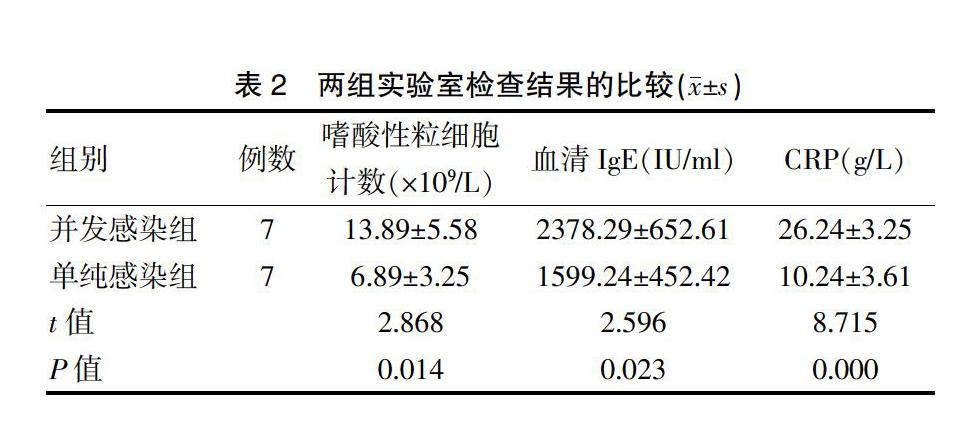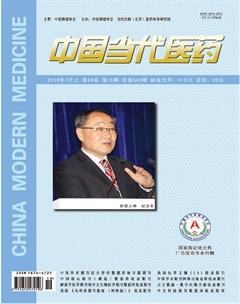儿童卫氏并殖吸虫感染并发多浆膜腔积液的临床特点分析
杨琴 马红玲 卢清华



[摘要]目的 探討儿童卫氏并殖吸虫感染并发多浆膜腔积液的临床特点,为临床诊断卫氏并殖吸虫感染所致多浆膜腔积液提供指导。方法 回顾性分析2007年3~12月我院收治的14例卫氏并殖吸虫感染患儿的临床资料,根据是否并发多浆膜腔积液分为单纯感染组(7例)和并发感染组(7例)。观察两组的嗜酸性粒细胞计数、血清免疫球蛋白E(IgE)、C反应蛋白(CRP)、T淋巴细胞亚群分化簇3(CD3+)、T淋巴细胞亚群分化簇4(CD4+)、T淋巴细胞亚群分化簇8(CD8+)、CD4+/CD8+,且评估两组的影像学检查结果。结果 单纯感染组与并发感染组的发热温度、发热时间、咳嗽类型、腹痛、呕吐等临床特征比较,差异无统计学意义(P>0.05);并发感染组的嗜酸性粒细胞计数、血清IgE、CRP均高于单纯感染组,差异有统计学意义(P<0.05);并发感染组的胸片异常率(100.00%)高于单纯感染组(42.86%),差异有统计学意义(P<0.05);并发感染组CD3+、CD8+高于单纯感染组,差异有统计学意义(P<0.05);并发感染组的CD4+、CD4+/CD8+低于单纯感染组,差异有统计学意义(P<0.05)。结论 儿童卫氏并殖吸虫感染所致多浆膜腔积液的临床特征不显著,为减少误诊或漏诊,应结合实验室检查、影像学检查对患儿实施诊断。
[关键词]儿童;卫氏并殖吸虫;感染;多浆膜腔积液;临床特征
[中图分类号] R532.22 [文献标识码] A [文章编号] 1674-4721(2019)7(a)-0158-03
[Abstract] Objective To investigate the clinical characteristics of children with Paragonimus westermani infection complicated with polyserosa effusion, and to provide guidance for clinical diagnosis of polyserosa effusion caused by Paragonimus westermani infection. Methods The clinical data of 14 children with Paragonimus westermani infection admitted to our hospital from March to December 2007 were retrospectively analyzed. According to whether they were complicated with multiple serous effusion, they were divided into simple infection group (7 cases) and complicated infection group (7 cases). Eosinophil count, serum immunoglobulin E (IgE), C-reactive protein (CRP), T lymphocyte subgroup differentiation cluster 3 (CD3+), T lymphocyte subgroup differentiation Cluster 4 (CD4+), T lymphocyte subgroup differentiation cluster 8(CD8+), CD4+/CD8+, and the imaging results of the two groups were evaluated. Results There were no significant differences in fever temperature, fever time, cough type, abdominal pain and vomiting between simple infection group and complicated infection group (P>0.05). The eosinophil count and serum IgE, CRP of children in complicated infection group were significantly higher than those in simple infection group (P<0.05). The abnormal rate of chest X-ray in the complicated infection group (100.00%) was higher than that in the simple infection group (42.86%) (P<0.05). The number of CD3, CD8 of children in complicated infection group was significantly higher than that in simple infection group (P<0.05). The differentiation cluster CD4 and CD4+/CD8+ of children in infection group were significantly lower than those in simple infection group (P<0.05). Conclusion The clinical features of polyserosa effusion caused by Paragonimus westermani infection in children are not significant. In order to reduce misdiagnosis or missed diagnosis, it is necessary to combine with laboratory examination and imaging examination to diagnose the children.

